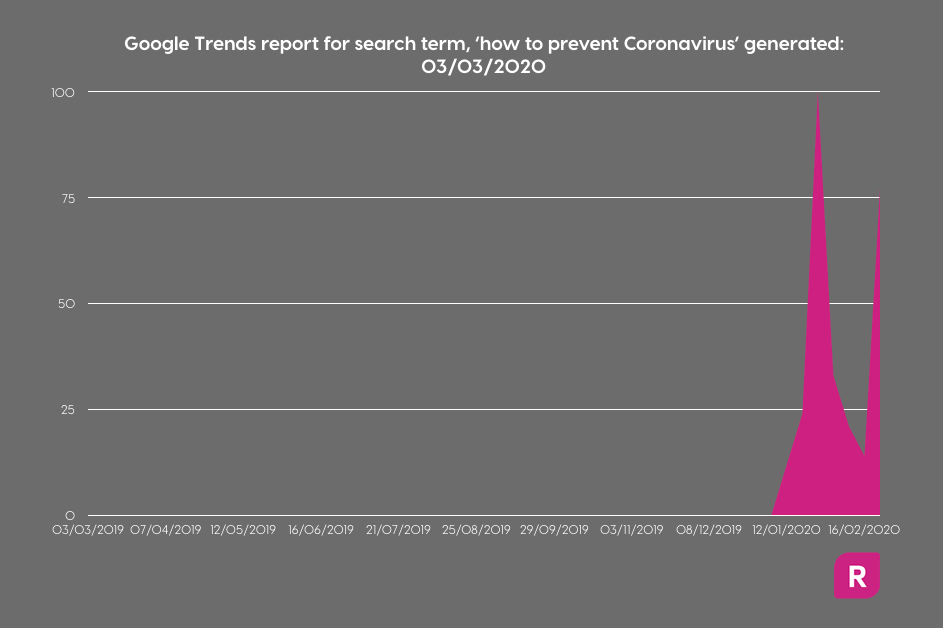What is health literacy, and why is it important? In a time of mixed messages and mass panic, how can healthcare organizations inform and protect the public in a clear and concise manner with good readability?
Why are health literacy and readability important during the Coronavirus outbreak?
Health literacy is important in healthcare because organizations need to help the public make informed health decisions. Good readability helps with comprehension - being well-informed means being more involved in your own care.
We need only look at a Google Trends chart for the spikes in the last couple of months to know people are frantically searching for how they can safeguard themselves and others.

Readability has a solid place in healthcare, with doctors being advised to avoid jargon in their correspondence being just one example.
Quite simply, if the general public can’t understand healthcare information, they don’t know where to turn - resources seem to conflict, and it’s hard to trust medical advice which is alienating.
This is definitely apparent in the Coronavirus outbreak. It’s everywhere we turn. It’s difficult to know what is sensationalism and what is a genuine cause for concern. It’s also difficult to know what advice to follow.
How does ‘the internet of things’ affect healthcare information?
Healthcare organizations face the challenge of cutting through the noise. Because there’s a plethora of information out there compared to traditional media, they more than ever need to be clear, concise and readable.
It’s a challenge everybody faces - if you can’t cut through the noise, how can a reader trust you as their go-to resource? It’s no different for healthcare professionals.
The searcher has a clear goal in mind when asking how they can protect themselves from Coronavirus. So if they can’t find the answer they’re looking for quickly, they may get frustrated and look to somebody else for the answer.
And if you’re an organization with a heavy responsibility - such as WHO - you’re going to want to be the clearest resource available.

How do Coronavirus resources rank for readability?
As shown in the Google Trends report, we based our results on the search term ‘how to prevent Coronavirus’. It’s certainly the question on everybody’s minds and we wanted to know who spells it out the most straightforwardly.
1 | WHO, ‘Basic protective measures against the new coronavirus’
Readable rating: A
What do they do right?: WHO has been a great resource during this outbreak, for its direct approach to public information.
A key part of being direct is using the active voice. The Readable analysis shows that this WHO webpage contains zero instances of passive voice. By avoiding the passive voice, WHO can take a no-nonsense approach to inform the public.
Their tone is on the formal side, which works for this kind of communication. The reader doesn’t want them to be chatty, they just want them to straightforwardly tell them how to stay clean and healthy.
2 | CDC, ‘Steps to Prevent Illness’
Readable rating: A
What do they do right?: Readable analysis for readability shows CDC only use 1% passive voice in this article. They also maintain a neutral tone, which is more helpful to the general public than a negative, alarmist tone. A negative tone could reduce the effectiveness of the information. There’s already enough panic in the news headlines.
Similarly to WHO, CDC maintains a slightly formal tone, communicating with the public clearly and portraying a trustworthy image.
3 | Healthline, ‘Everything You Should Know About the 2019 Coronavirus and COVID-19’
Readable rating: B
What do they do right?: Readable shows that this webpage should be readable for 97% of the addressable audience, which equates to approximately 82% of the general public.
Healthline also uses another great example of direct language - keeping an eye on their adverb use. This page contains only 2% adverbs. Using too many adverbs can slow down the pace of a text and make it less memorable. Being judicious in our adverb choices can make us all better writers and communicators.
Readability best practices for COVID-19
In a climate of panic and misinformation, it’s even more important than usual to use plain language and clear communication. The recommended Flesch Kincaid grade level for health information is below grade 8. When health information exceeds this, comprehension is reduced.
Being clear, concise and readable allows us to communicate advice effectively. There are several reasons why Google has ranked these resources highly - readability is an important part of the puzzle.
Clearly stating the symptoms, risk factors and preventative measures cuts through the noise and mixed messages we’re seeing every day on this topic.


